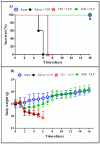Salivary Gland Extract from Aedes aegypti Improves Survival in Murine Polymicrobial Sepsis through Oxidative Mechanisms
- PMID: 30360497
- PMCID: PMC6262460
- DOI: 10.3390/cells7110182
Salivary Gland Extract from Aedes aegypti Improves Survival in Murine Polymicrobial Sepsis through Oxidative Mechanisms
Abstract
Sepsis is a systemic disease with life-threatening potential and is characterized by a dysregulated immune response from the host to an infection. The organic dysfunction in sepsis is associated with the production of inflammatory cascades and oxidative stress. Previous studies showed that Aedes aegypti saliva has anti-inflammatory, immunomodulatory, and antioxidant properties. Considering inflammation and the role of oxidative stress in sepsis, we investigated the effect of pretreatment with salivary gland extract (SGE) from Ae. aegypti in the induction of inflammatory and oxidative processes in a murine cecum ligation and puncture (CLP) model. Here, we evaluated animal survival for 16 days, as well as bacterial load, leukocyte migration, and oxidative parameters. We found that the SGE pretreatment improved the survival of septic mice, reduced bacterial load and neutrophil influx, and increased nitric oxide (NO) production in the peritoneal cavity. With regard to oxidative status, SGE increased antioxidant defenses as measured by Trolox equivalent antioxidant capacity (TEAC) and glutathione (GSH), while reducing levels of the oxidative stress marker malondialdehyde (MDA). Altogether, these data suggest that SGE plays a protective role in septic animals, contributing to oxidative and inflammatory balance during sepsis. Therefore, Ae. aegypti SGE is a potential source for new therapeutic molecule(s) in polymicrobial sepsis, and this effect seems to be mediated by the control of inflammation and oxidative damage.
Keywords: Aedes aegypti; CLP model; oxidative stress; saliva; salivary gland extract; sepsis.
Conflict of interest statement
The authors declare no competing interests.
Figures








Similar articles
-
Aedes aegypti salivary gland extract alleviates acute itching by blocking TRPA1 channels.Front Physiol. 2023 Jun 27;14:1055706. doi: 10.3389/fphys.2023.1055706. eCollection 2023. Front Physiol. 2023. PMID: 37441000 Free PMC article.
-
Aedes aegypti saliva impairs M1-associated proinflammatory phenotype without promoting or affecting M2 polarization of murine macrophages.Parasit Vectors. 2019 May 16;12(1):239. doi: 10.1186/s13071-019-3487-7. Parasit Vectors. 2019. PMID: 31097013 Free PMC article.
-
Aedes aegypti salivary gland extract ameliorates experimental inflammatory bowel disease.Int Immunopharmacol. 2015 May;26(1):13-22. doi: 10.1016/j.intimp.2015.03.002. Epub 2015 Mar 12. Int Immunopharmacol. 2015. PMID: 25770821
-
Evaluation of inflammatory skin infiltrate following Aedes aegypti bites in sensitized and non-sensitized mice reveals saliva-dependent and immune-dependent phenotypes.Immunology. 2019 Sep;158(1):47-59. doi: 10.1111/imm.13096. Immunology. 2019. PMID: 31315156 Free PMC article.
-
Unraveling the Multifaceted Role of Glutathione in Sepsis: A Comprehensive Review.Cureus. 2024 Mar 25;16(3):e56896. doi: 10.7759/cureus.56896. eCollection 2024 Mar. Cureus. 2024. PMID: 38659506 Free PMC article. Review.
Cited by
-
Lipid Fraction from Agaricus brasiliensis as a Potential Therapeutic Agent for Lethal Sepsis in Mice.Antioxidants (Basel). 2024 Jul 30;13(8):927. doi: 10.3390/antiox13080927. Antioxidants (Basel). 2024. PMID: 39199173 Free PMC article.
-
β-Lapachone Increases Survival of Septic Mice by Regulating Inflammatory and Oxidative Response.Oxid Med Cell Longev. 2020 Dec 12;2020:8820651. doi: 10.1155/2020/8820651. eCollection 2020. Oxid Med Cell Longev. 2020. PMID: 33381269 Free PMC article.
-
ACE2 shedding exacerbates sepsis-induced gut leak via loss of microbial metabolite 5-methoxytryptophan.Microbiome. 2025 May 29;13(1):136. doi: 10.1186/s40168-025-02128-4. Microbiome. 2025. PMID: 40442816 Free PMC article.
-
Aedes-Chikungunya Virus Interaction: Key Role of Vector Midguts Microbiota and Its Saliva in the Host Infection.Front Microbiol. 2019 Apr 9;10:492. doi: 10.3389/fmicb.2019.00492. eCollection 2019. Front Microbiol. 2019. PMID: 31024463 Free PMC article. Review.
-
Aedes aegypti salivary gland extract alleviates acute itching by blocking TRPA1 channels.Front Physiol. 2023 Jun 27;14:1055706. doi: 10.3389/fphys.2023.1055706. eCollection 2023. Front Physiol. 2023. PMID: 37441000 Free PMC article.
References
-
- Seymour C.W., Liu V.X., Iwashyna T.J., Brunkhorst F.M., Rea T.D., Scherag A., Rubenfeld G., Kahn J.M., Shankar-Hari M., Singer M., et al. Assessment of clinical criteria for sepsis for the third international consensus definitions for sepsis and septic shock (sepsis-3) J. Am. Med. Assoc. 2016;315:762–774. doi: 10.1001/jama.2016.0288. - DOI - PMC - PubMed
-
- Singer M., Deutschman C.S., Seymour C., Shankar-Hari M., Annane D., Bauer M., Bellomo R., Bernard G.R., Chiche J.D., Coopersmith C.M., et al. The third international consensus definitions for sepsis and septic shock (sepsis-3) J. Am. Med. Assoc. 2016;315:801–810. doi: 10.1001/jama.2016.0287. - DOI - PMC - PubMed
-
- Barros L.L.d.S., Maia C.d.S.F., Monteiro M.C. Fatores de risco associados ao agravamento de sepse em pacientes em Unidade de Terapia Intensiva. Cad. Saúde Coletiva. 2016;24:388–396. doi: 10.1590/1414-462x201600040091. - DOI
Grants and funding
LinkOut - more resources
Full Text Sources
Miscellaneous

